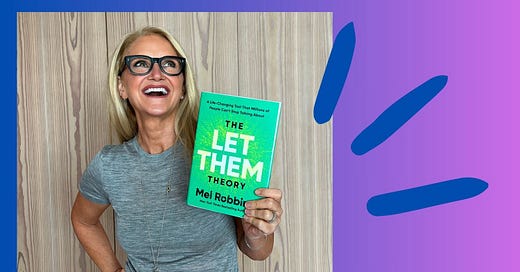The Let Them Theory is making me a badass
+ Let’s talk about the link between menopause and divorce
Thank you to our sponsor, MenoLabs, makers of MenoFit and Well Rested.
What is The Let Them Theory?
I’m a little late to the Mel Robbins party, but after reading her book The Let Them Theory, I’ve got to share the highlights in my usual round-up fashion.
The Let Them Theory has helped me prioritize what’s most important, reduce negative thoughts, and take action on the million things on my never-ending “Really Want To-Do List.”
The Let Them Theory isn’t exactly a novel idea — it’s a refreshing packaging of common sense. In fact, Robbins talks openly about how her theory aligns with aspects of established psychological theories like the locus of control theory, Buddhist principles, and attachment theory. The Let Them Theory also shares elements with Transactional Analysis, Cognitive Behavioral Therapy (CBT), and Acceptance and Commitment Therapy (ACT).
I think of The Let Them Theory as a proactive, no-bullshit mindset shift that the majority of we beautifully messy “normal” (read: emotional, overthinking) people can benefit from. Let’s dig in.

What is the Let Them Theory?
Let Them is a philosophy or way of thinking in which you “allow” people to think whatever they want. When you let people do whatever it is that they want to do, it creates more control and emotional peace for you and a better relationship with the people in your life. Believers of the Let Them Theory free themselves of the exhausting cycle of trying to manage everything and everyone around them.
It’s a simple idea when you think about it, but the process of letting go of the control you do not have over other people’s opinions is a game-changing stress reliever. Sometimes, the most profound changes in life come from the simplest acts, right?
Already today, I’ve applied Let Them to “let the traffic jam take its time,” “let my backyard be flooded by a broken sprinkler system while I wait for the repairperson to come,” and “let my daughter be frustrated with waking up early on a Friday.” I know, sounds kinda quirky, but really: I cannot control traffic, a broken sprinkler system, nor my daughter’s emotions.
To be clear, letting go isn’t about ignoring what’s right in front of our face. It’s about acknowledging and moving forward. This distinction is vital because it ensures that we don’t suppress our feelings, which can lead to more emotional turmoil.
The Let Them Theory Tactics
The 5-Second Rule
(Not to be confused with the 10-second rule of picking food up off the floor.)
When you have an urge to act on something, count down from 5 to 1 and then immediately take the action, before you have a chance to overthink and talk yourself out of it. This helps overcome the hesitation and procrastination that hold you back and lead to rumination and inaction. By counting down and making a conscious decision to release negative thoughts, you can shift your focus toward positive outcomes.
Focus on Action
You are not going to win if you keep telling yourself to wait, and that the more often that you choose courage, the more likely you’ll succeed.
Find Your “One Thing”
Identify what truly excites you and dedicate your time and energy to exploring and pursuing that passion.
Menopause rage: Let’s talk about the link between menopause and divorce
My husband is bent down on one knee in front of our corner kitchen cabinet where we keep the Tupperware. The cabinet has two Lazy Susan shelves that spin, making it easy to organize whatever is stored there — easy unless the cabinet is so cluttered that some of the Tupperware has fallen off the shelves, blocking the Lazy Susans from turning. He is irritated.
“Why do we let this cabinet get so messy?” he asks no one in particular. “We’ve got too much in here. We don’t even use it all. Some of these bowls don’t even have lids.” By the time I make my way into the kitchen to see what he’s talking about, he is holding a garbage bag nearly full of Tupperware.
“This is all going in recycling,” he says when he sees me.
“No, it’s absolutely not,” I say. Without warning, I am defiant and indignant. Unsurprisingly to no one in my house, I am, almost instantaneously, mad and ready to fight … about Tupperware. Not just Tupperware, but Tupperware we don’t need that my husband has taken the time to declutter and recycle. This is my menopause.
Which menopause symptoms impact our relationships?
In addition to menstrual cycle changes (or lack thereof), the American College of Obstetricians and Gynecologists (ACOG) lists three — yes, only three — primary perimenopause symptoms on an FAQ page under a section of its website titled “The Menopause Years.” The three “signs and symptoms” are hot flashes, sleep disorders, and vaginal and urinary tract changes. The generous use of the word ‘changes’ in that last symptom immediately makes me rageful. The Mayo Clinic’s website confirms a few more symptoms beyond the obvious three, including chills, night sweats, weight gain and slowed metabolism, thinning hair and dry skin, loss of breast fullness, and mood changes.
The phrase “mood changes,” (FYI, I consider this a generous use of the word “changes”), feels closer to what I’m going through. After reading the limited number of symptoms provided by the ACOG and Mayo Clinic, it makes total sense why I feel so much menopausal rage. My body isn’t just changing, it’s metamorphosing and the only thing that comes close to explaining how I feel is Mary Ruefle’s essay “Pause” published in Granta Magazine eight years ago.
“Reading this, or any other thing ever written about menopause, will not help you in any way, for how you respond to menopause is not up to you, it is up to your body, and though you believe now that you can control your body (such is your strength after all that yoga), you cannot,” writes Ruefle.
I’m finding that not only can I not control my body, I struggle to contain my emotional responses to events that wouldn’t even generate a beep on my cognitive radar a few short years ago. It is as if my menopausal body is now a divining rod for my soul’s lowest possible vibrational frequency. My marriage is the unfortunate casualty of all this rage because it’s usually my husband in the room when I go off the rails.
Thanks again to our sponsor, MenoLabs, makers of MenoFit and Well Rested.












I have a few girlfriends who are neck-deep in this book, and they all agree that it's helping them reduce their people-pleasing tendencies more than any therapy they've tried. Question: is this something that could only be written by a menopausal woman, with that high-level wisdom that comes during this time of our lives, and should we all be working toward our own wisdom books???